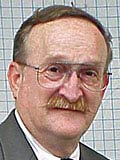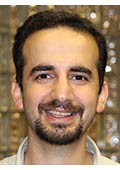Doctoral students develop model for new flexible structural system

Michael Bunch

Saied Zarrinmehr
Models of an innovative flexible structural system that could significantly reduce the amount of steel required to construct bridges, arches, domes and columns have been produced as part of an ongoing project by Michael Bunch and Saied Zarrinmehr, two [Ph.D. architecture] (http://dept.arch.tamu.edu/graduate/phd/) students at Texas A&M.
The models of an arch and a column, produced in the 3-D printer in the College of Architecture’s [woodshop] (http://www.arch.tamu.edu/inside/services/woodshop/) using a script developed by Zarrinmehr, “clearly demonstrate that when industrial-grade metal plotting equipment is used, this system can be built with exceptionally high degrees of accuracy and be fully compatible with design intent,” said Bunch.
The system is the result of Bunch’s combination of “ [golden mean] (http://community.middlebury.edu/~harris/Humanities/TheGoldenMean.html) ratios,” a standard proportion for width’s relation to height used in architecture and art for centuries, the radius of rotation around the centerline of DNA molecules, and the dimensions of a mathematical curve called a [Koch Star] (http://community.middlebury.edu/~harris/Humanities/TheGoldenMean.html) .
“Golden mean ratios occur repeatedly in design and in nature, DNA’s rotation radius has been around for millions of years, and the Koch Star appears in many types of analysis of natural and manmade objects,” said Bunch.
Bunch’s use of patterns in nature to inform his work is called [biomimicry] (http://biomimicry.net/about/biomimicry38/institute/) , an innovative approach that seeks sustainable solutions by emulating nature’s time-tested patterns and strategies.
“We have a great deal to learn from nature,” said Bunch. “Nature rarely wastes anything. If it doesn’t work in the most efficient manner it ceases to exist.”
With Zarrinmehr’s script, which includes more than 1000 lines of code, an arch that could serve as a structural support or as a rib in a vault can be built by installing additional arches at geometrically compatible points, as architects have done for centuries, said Bunch.
Zarrinmehr’s script also maximizes the concept’s flexibility, said Bunch.
“By varying parameters in any of the system’s coordinate planes, we could generate virtually any shape that might be desired,” said Bunch. “With only a little extrapolation one can see how the process could ultimately be extended to new nano materials,” he said. “The applications of computer-guided systems like these, in concert with biomimicry, could potentially be limitless.”
During his work on the project in the fall 2012 semester, Bunch tested the strength of columns using the system he devised made with 3/8-inch rebar 54 inches tall with a 12-inch triangular base.
He built the columns at the College of Architecture’s [Digital Fabrication Facility] (http://www.arch.tamu.edu/inside/services/digital-fabrication/) , tested them with a hydraulic compressive testing machine in the Department of Civil Engineering’s structural lab, was unhappy with the results, refined the design, tested them again and found the columns were much stronger.
Bunch said the system could be manufactured from tubes of high-density nanoparticles or carbon fiber using 3-D printers, or built with conventional materials on computer-aided bending, welding and CNC equipment.
Previous post
Tags
- architecture
- building a better texas
- fabrication
- feature
- graduate work
- interdisciplinary
- research
- rss
- technology
Related Posts
Solar light pipe testing to begin
Art and technology merge in students' design exploration

Faculty envision 3-D printing’s future, earn ‘Vision Award’

Innovative ‘green’ wall features sheet metal, native plants
Follow Us
Facebook Twitter Vimeo Youtube Flickr RSS
Recent Posts

Planning prof heads study of disaster housing aid

A message from the dean

Former student remembered as expert planner

Leading educator named new head of Architecture Dept.








_thumbnail_small.png)
